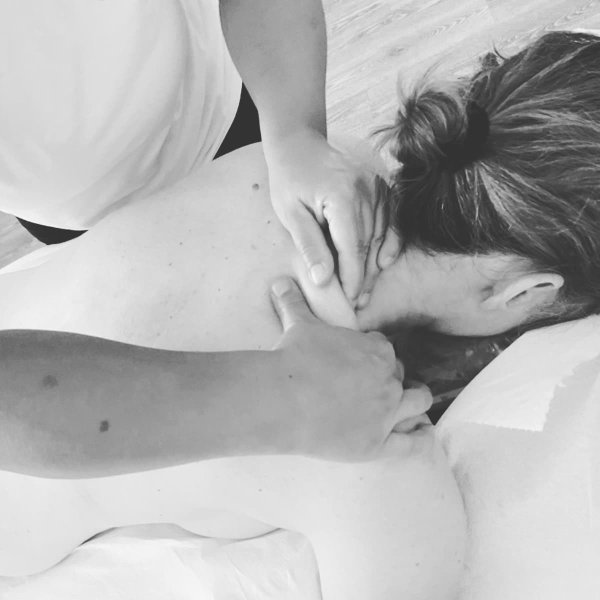Massages
- Classic massage (Swedish)
- Full-body or partial-body massage
- Lomi Lomi Nui
- Sports massage
- Trigger-point massage
- Reflexology massage for hands and feet
- Fascial massagen (Stecco technique)
- Draining massage with pennywort
- Gentle massage targeting menopausal difficulties
Massage (from French masser, "to knead," in Arabic مس "to touch“ or from the Greek μάσσω " to chew, to knead“) is a mechanical way to influence the skin, connective tissue and musculature. The massage affects not only the body but also the psyche. In the broadest sense, massage is one of humankind's oldest remedies. In his book, Franz Kirchberg put it this way:
Just as every person instinctively touches a swollen and thus painful point on the body, in order to reduce the pain, so has this instinct become a method of healing through the ages, in the form of a massage.
The original use of massage in healing was probably in East Africa and Asia (Egypt, China, Persia). The first historical mention is from Chinese healer Huang Di, who described massage techniques and exercizes as early as 2600 BC. In combination with essential oils and herbs, early health and healing wisdom in India came into being: Ayurveda.
General effect
- Local increase in blood flow
- Lowering blood pressure and pulse rate
- Relaxation of the musculature
- Loosening bonds and scars
- Improved wound healing
- pain relief
- Acting on internal organs via reflex arches
- Psychic relaxation
- Reduction of stress
- Improvement of cell metabolism in the tissue
- Relaxation of skin and connective tissue
- Influencing the autonomic nervous system
Classical massage (swedish massage)
The indications of the classic massage include tensions, hardening, disorders of the musculoskeletal system such as spinal syndromes or even post-traumatic changes. The reflex arches can cause diseases of the internal organs on the skin or the muscles. Another field of application of massage is the field of neurology. Here you can especially treat paresis, spasticity, neuralgia and sensibility disorders. Added to this are the psychosomatic illnesses attributable to stress, which mainly relate to the heart and blood circulation.
Full- / partial body massage
A full body massage is when more or less all parts of the body are massaged. This usually includes feet, legs, arms, hands, back, shoulders and neck. The massage can be extended to the chest, abdomen and face. The whole body massage is rarely prescribed as a medical therapy.
In the partial body massage, only one part of the body is massaged. Both legs or both arms count here as a body part. This results in the following partial massage areas: legs, back (lying and with free upper body), arms, chest, stomach, face. Each masseur has his own type of massage and will extend a partial body massage to the adjacent areas.
Holistic massage
Indication: muscle strain, general overload of the body. Massage serves us gesupered people, as a way to flush out and clear stress blocks. For competitive athletes is such a good thing that you have to prepare for peak performance.
Lomi Lomi Nui
In the vernacular, lomi means rubbing, kneading or squeezing, doubling this meaning. Nui means big, important or unique. Lomi Lomi Nui can be translated as "unique strong kneading" as a term for a special massage form.
In a healthy body, energy (mana) flows, diseases cause blockages that manifest as body tension. The massage is intended to release these blockages on a physical and emotional level and restore the harmony of body, mind and soul.
It uses a lot of oil, originally from the kukui nut. The practitioner not only works with the hands but with the entire forearm including the elbows.
Reflexology
Sports massage
Faszientherapie - Massage after Stecco
Gentle massages for menopausal complaints
Used products

